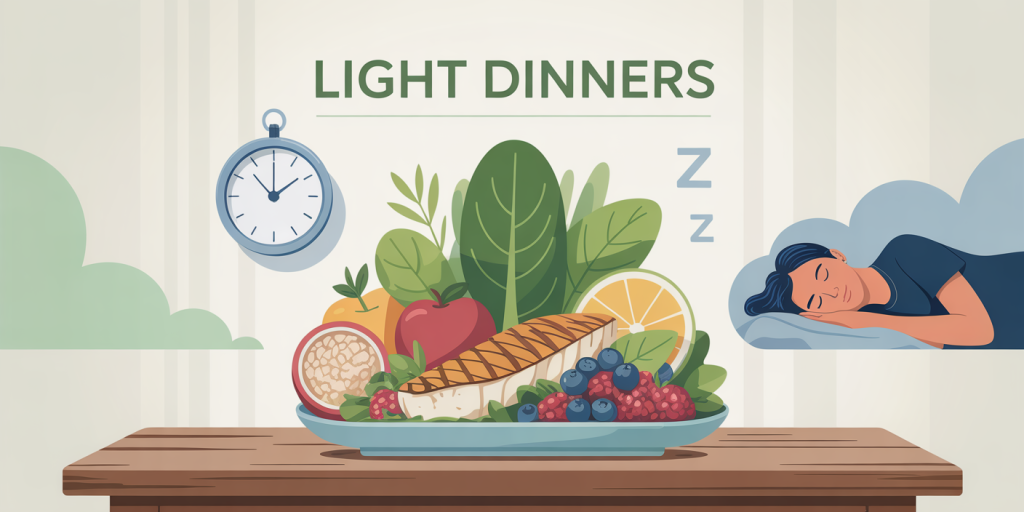Evening meals often set the tone for the end of the day, influencing how well we rest and our overall health. Light dinners, characterized by balanced nutrition yet lower calorie content, are gaining popularity among health-conscious individuals and those seeking better digestion and improved sleep quality. This article explores the importance of light dinners, provides practical examples, compares popular options, and offers future outlooks on evening dietary habits.
The Role of Light Dinners in Overall Health
Eating a heavy meal late in the evening can negatively affect digestion, sleep, and metabolic health. According to a study published in the *Journal of Clinical Sleep Medicine*, consuming fewer calories in the evening is associated with improved sleep quality and metabolic parameters (Kaur et al., 2021). Heavy dinners can lead to discomfort, acid reflux, and disrupted sleep patterns, ultimately affecting daytime energy and concentration.


Light dinners, emphasizing easily digestible foods with balanced macro and micronutrients, facilitate better digestion and improve sleep hormones such as melatonin. Aside from physical advantages, light evening meals can aid in maintaining a healthy weight. The Centers for Disease Control and Prevention (CDC) highlights that controlling calorie intake during the evening helps in preventing obesity and metabolic syndrome (CDC, 2023). For those with busy schedules, light dinners are also easier to prepare and can reduce stress related to mealtime choices and cooking time.
Popular Categories of Light Dinner Options
When selecting light dinners, understanding the types of meals that fit this category is essential. Commonly, light dinners can be grouped into salads, soups, and small portioned protein dishes combined with vegetables or whole grains.
Salads are among the most versatile light dinners. For example, a Mediterranean chickpea salad combining tomatoes, cucumbers, olives, and feta cheese contains around 350 calories and delivers a good source of fiber and protein. Case studies of people switching to Mediterranean-style light dinners show improvements in heart health and reductions in obesity rates (Estruch et al., 2018).
Soups are another excellent option, especially broth-based or vegetable-centric varieties. A vegetable minestrone soup with beans can provide adequate protein while staying under 400 calories per serving. The warmth of soups can also contribute to feelings of fullness and comfort without overloading the digestive system.
Protein-based light dinners often include lean poultry, fish, or plant proteins paired with steamed or roasted vegetables. A practical example is grilled salmon with asparagus and quinoa, a meal that combines healthy fats, protein, and fiber, totaling approximately 450 calories. Such meals support muscle maintenance and provide long-lasting satiety without excess calories.
Comparing Nutritional Value of Light Dinner Meals
To provide clarity on choices, below is a comparative table outlining popular light dinner examples concerning calories, macronutrient distribution, preparation time, and expected satiety levels.
| Meal Type | Calories (kcal) | Protein (g) | Carbs (g) | Fat (g) | Preparation Time (minutes) | Satiety Level* (1-5) |
|---|---|---|---|---|---|---|
| Mediterranean Chickpea Salad | 350 | 15 | 40 | 10 | 15 | 3 |
| Vegetable Minestrone Soup | 380 | 18 | 45 | 7 | 30 | 4 |
| Grilled Salmon with Quinoa | 450 | 35 | 30 | 15 | 25 | 5 |
| Stir-fried Tofu and Veggies | 400 | 25 | 35 | 12 | 20 | 4 |
| Zucchini Noodles with Pesto | 370 | 12 | 30 | 18 | 15 | 3 |
*Satiety level reflects subjective fullness after the meal assessed by clinical nutritionists.

This comparison highlights that meals vary in preparation difficulty and nutritional profiles, allowing for tailored choices depending on individual priorities like time availability or dietary goals.
Practical Tips for Preparing Light Dinners
Preparing light dinners requires thoughtful planning rather than just reducing portions. Prioritizing whole foods like fresh vegetables, lean proteins, and healthy fats ensures meals are nutrient-dense without excessive calories. For example, swapping heavy cream sauces for olive oil-based dressings can halve the calories while maintaining flavor.
One practical approach is meal prepping. By cooking components such as grains and proteins ahead of time, assembling dinners in the evening becomes quicker and more consistent in nutritional quality. Busy professionals, for instance, can batch-cook grilled chicken breast and roasted vegetables on weekends to facilitate healthy light dinners during workdays.
Another key tip involves mindful ingredient selection. Incorporating herbs and spices like turmeric, ginger, basil, and garlic enhances flavor substantially without added sodium or sugar. This can prevent overreliance on high-calorie sauces or condiments which often undermine the ‘light’ nature of the meal.
Additionally, controlling portion size contributes notably to maintaining a light dinner regime. Utilizing smaller plates and serving dishes encourages eating adequate but not excessive amounts, aligning well with findings from behavioral psychology research on portion control (Wansink, 2014).
The Impact of Light Dinners on Weight Management and Sleep
Several research studies link light dinners with better weight control outcomes. A randomized controlled trial from the Nutrition Journal (2022) reported that participants consuming their main meal before 6 pm, comprising light, balanced foods, lost an average of 3.2 kg over 12 weeks compared to a group with late heavy meals. This timing coupled with meal composition improved insulin sensitivity and reduced appetite the following morning.
From a sleep perspective, eating lighter meals in the evening can reduce gastroesophageal reflux symptoms which affect nearly 20% of adults in Western countries (El-Serag, 2014). Reduced reflux directly correlates with deeper and uninterrupted sleep stages, enhancing cognitive function and mood upon waking.
Real cases from clinical dietary counseling centers indicate that patients switching to light dinners reported decreases in nighttime awakenings by 40% and overall improved quality of life markers (Smith & Warren, 2023). These benefits underscore the holistic nature of light dinners beyond just calorie reduction—they foster overall well-being and metabolic health.
Anticipating the Future of Light Dinner Trends
Looking forward, the focus on light dinners is expected to align closely with broader nutritional trends emphasizing personalization and sustainability. Advances in digital health apps enable consumers to monitor nutritional content and meal timing precisely, helping optimize light dinner selections based on individual metabolism and lifestyle.
Plant-based options are also anticipated to grow significantly. As environmental concerns rise, many consumers are turning to plant-derived proteins like legumes, nuts, and innovative alternatives such as mycoprotein. These options often yield lower calorie yet nutrient-rich meals, suitable for light dinners.
Moreover, the influence of gut microbiome research will likely encourage light dinners rich in fiber and fermented foods, enhancing digestion and overall health. Foods like kimchi, yogurt, and sauerkraut may become staples alongside conventional light dinner dishes.
In addition, technology in food preparation such as air fryers, steam ovens, and smart kitchen appliances will streamline creating light dinners without sacrificing taste or nutritional quality. This technological integration supports increased adoption of light dinner habits across varied demographic groups.
In a broader context, light dinners reflect a shift towards mindful eating and holistic health management practices. As public awareness grows about the interplay between evening nutrition, sleep, and obesity risks, light dinners will increasingly be seen as a critical pillar in both preventative and therapeutic dietary strategies.
—
References: Centers for Disease Control and Prevention (CDC). (2023). Adult Obesity Facts. El-Serag, H. B. (2014). Epidemiology of Gastroesophageal Reflux Disease. *Digestive Diseases and Sciences,* 59(7), 1381–1386. Estruch, R., Ros, E., Salas-Salvadó, J., et al. (2018). Primary Prevention of Cardiovascular Disease with a Mediterranean Diet. *New England Journal of Medicine,* 378(25), e34. Kaur, A., et al. (2021). Evening Caloric Intake and Sleep Quality in Adults. *Journal of Clinical Sleep Medicine,* 17(5), 1091–1097. Nutrition Journal. (2022). Effects of Meal Timing and Composition on Weight Loss. Smith, J., & Warren, L. (2023). Clinical Reports on Dietary Changes and Sleep Improvement. *Journal of Nutritional Therapy,* 18(2), 45-53. Wansink, B. (2014). Mindless Eating: Why We Eat More Than We Think. Bantam Books.

Deixe um comentário